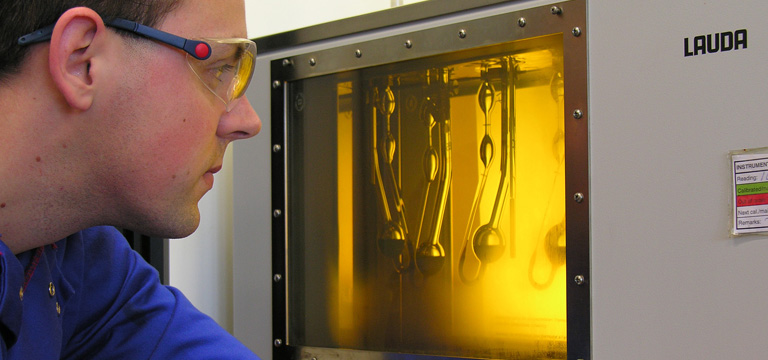
荷兰
突出的操作
在荷兰,雪佛龙正在经营润滑油营销和零售业务,以及一个开发添加剂的研究中心。我们在子公司Chevron Netherlands B.V.和Chevron Oronite Technology B.V.下开展业务BOB体育平台是合法的吗
鹿特丹是雪佛龙奥伦耐子公司的全球海洋润滑油添加剂BOB体育平台是合法的吗研究技术中心。该实验室还负责欧洲、非洲和中东地区的发动机油添加剂开发。
雪佛龙在邻近的比利时根特生产润滑油,拥有一支经验丰富的销售队伍,通过经销商网络直接向荷兰客户销售润滑油。我们也在鹿特丹港向远洋船只出售船用润滑油。
业务组合
营销和零售
在我们鹿特丹的办公室,我们的子公司雪佛龙荷兰B.V.通过德士古®、Havoline®、Ursa®、Delo®和Techron®品牌直接向消费者、商业和工业客户并通过授权经销商销售润滑油、冷却剂和燃料处理。
我们也为海洋市场销售润滑油。雪佛龙的润滑油主要基于第二组优质基础油,从我们自己在美国的炼油厂进口。雪佛龙是这些基础油的世界领先生产商。
oronite
我们的子公司雪佛龙奥伦耐技术有限公司BOB体育平台是合法的吗经营着鹿特丹技术实验室,在那里我们进行BOB体育平台是合法的吗润滑油添加剂的研究。
该设施包括一个发动机测试实验室,重点测试汽车和大型船舶柴油机添加剂。该实验室满足欧伦耐®添加剂客户在欧洲、非洲和中东的发动机油开发需求。
鹿特丹设施也是奥隆海洋润滑剂添加剂研究的全球技术中心。BOB体育平台是合法的吗
成就的记录
雪佛龙在荷兰的工作始于一个多世纪前。
德士古公司于1902年左右开始在荷兰运营,后来与雪佛龙公司合并。第二次世界大战后,我们开始以Caltex®品牌销售燃料。
我们于1962年开始沿岸探索活动。这导致了1967年颁发的Akkrum特许权,在2003年退役之前生产了30多年的天然气。农村遗址已恢复到原州并回收用于农业用途。
2005年,雪佛龙收购了优尼科及其在荷兰的权益。该公司自20世纪60年代中期以来一直活跃在该国。
此外,2005年,雪佛龙和我们的合作伙伴被授予生产许可证,从而能够开发荷兰北海的A / B浅气田。2007年块A12中安装了中央处理平台和出口管道。2011年,无人驾驶B13卫星平台开始生产。
1982年,第一油是由荷兰队伍的块Q1中的Helder和Helm平台生产的。雪佛龙在2012年庆祝了这一重要里程碑的30周年。
2014年11月,雪佛龙剥离了其在北海荷兰地区的勘探和生产权益,并出售了雪佛龙运输业务。
健康,环境和安全
雪佛龙公司的卓越运作管理系统旨在提高每天的安全,环境和健康表现,编织到我们运营的各个方面。
雪佛龙采用“停止工作授权”政策,该政策规定,当不安全的情况或行为可能导致不希望发生的事件时,任何个人都有责任和权力停止工作而不受影响。
经济与技术BOB体育平台是合法的吗
雪佛龙通过润滑油和燃料添加剂的研究以及作为雇主为荷兰的经济做出了贡献。
接触
Petroleumweg 32
3196 KD Vondelingenplaat
荷兰
电话:+ 31.0.10.295.1400
传真:+ 31.0.10.438.1292
Petroleumweg 32
3196 KD Vondelingenplaat
荷兰
电话:+ 31.0.10.295.1400
传真:+ 31.0.10.438.1292
1995年私人证券诉讼改革法案“安全港”条款中有关前瞻性信息的警示声明
本网站基于管理层对石油、化工和其他能源相关行业的当前预期、估计和预测,包含与雪佛龙业务相关的前瞻性陈述。单词或短语如“预期”、“期望”、“打算”、“计划”、“目标”、“预测”、“项目”、“相信”、“寻求”、“时间表”、“估计”、“职位”、“追求”、“可能”、“可能”、“应该”、“将”、“预算”、“展望”、“趋势”、“指导”、“焦点”、“按计划”、“按计划”、“按计划”、“预定”、“目标”、“目标”、“战略”、“机会”、“泰然自若”、“潜力”以及类似的表达是用来确定这些前瞻性陈述的。这些报表并不是未来业绩的保证,而且受到某些风险、不确定性和其他因素的影响,其中许多是公司无法控制的,难以预测。因此,实际的结果和结果可能与这些前瞻性陈述中所表达或预测的内容有很大的不同。读者不应过分依赖这些前瞻性陈述,这些陈述仅在本网站公布的日期发表。除非法律要求,雪佛龙没有义务公开更新任何前瞻性陈述,无论是由于新信息、未来事件或其他原因。
可能导致实际结果与前瞻性陈述中预期的实际结果不同的重要因素是:改变原油和天然气价格;改变炼油,营销和化学品利润率;该公司能够实现与企业转型举措相关的预期成本节约和效率;竞争对手或监管机构的行动;勘探费用的时间;原油升水的时间;替代能源或产品替代品的竞争力;技术发展;公司供应商,供应商,合作伙伴和股权附属公司的业务和财务状况,特别是在较低的原油和天然气价格低位期间;公司的合资伙伴无能或失败,以资助其业务和发展活动的份额; the potential failure to achieve expected net production from existing and future crude oil and natural gas development projects; potential delays in the development, construction or start-up of planned projects; the potential disruption or interruption of the company’s operations due to war, accidents, political events, civil unrest, severe weather, cyber threats, terrorist acts, and public health crises, such as pandemics and epidemics; crude oil production quotas or other actions that might be imposed by the Organization of Petroleum Exporting Countries and other producing countries, or other natural or human causes beyond the company’s control; changing economic, regulatory and political environments in the various countries in which the company operates; general domestic and international economic and political conditions; the potential liability for remedial actions or assessments under existing or future environmental regulations and litigation; significant operational, investment or product changes required by existing or future environmental statutes and regulations, including international agreements and national or regional legislation and regulatory measures to limit or reduce greenhouse gas emissions; the potential liability resulting from pending or future litigation; the company’s future acquisitions or dispositions of assets or shares or the delay or failure of such transactions to close based on required closing conditions; the potential for gains and losses from asset dispositions or impairments; government-mandated sales, divestitures, recapitalizations, industry-specific taxes, tariffs, sanctions, changes in fiscal terms or restrictions on scope of company operations; foreign currency movements compared with the U.S. dollar; material reductions in corporate liquidity and access to debt markets; receipt of required Board authorizations to effect future dividend and share repurchases; the effects of changed accounting rules under generally accepted accounting principles promulgated by rule-setting bodies; the company's ability to identify and mitigate the risks and hazards inherent in operating in the global energy industry; and the factors set forth under the heading “Risk Factors” on pages 18 through 21 of the company’s 2019 Annual Report on Form 10-K and in subsequent filings with the U.S. Securities and Exchange Commission. Other unpredictable or unknown factors not discussed on this Website could also have material adverse effects on forward-looking statements.
